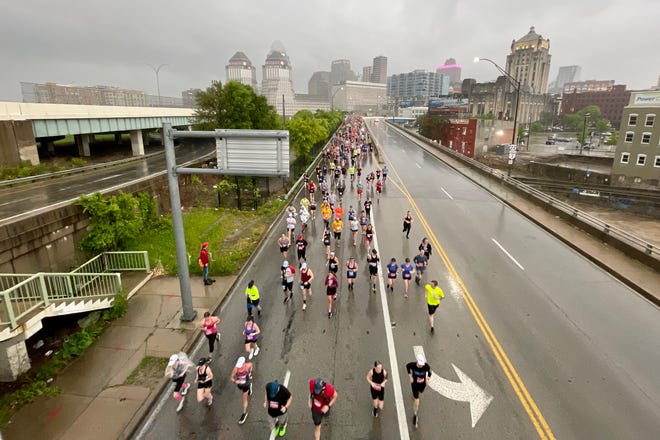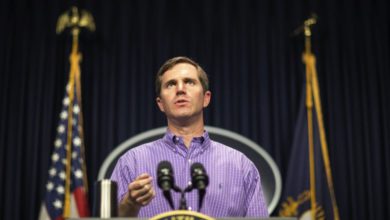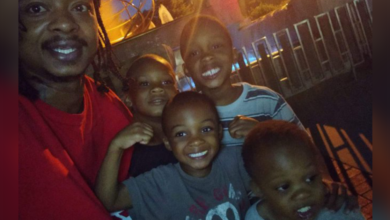
Prior to the 25th running of the Flying Pig Marathon, race director Iris Simpson-Bush took the microphone at the start line and issued a verbal green flag to start the 26.2-mile race.
Storms were a worry, but early indications were for conditions to be fine early with the hope of bad weather passing through without major incident. As the national anthem was sung, there was a brief downpour. Then as the fire blazed from each side of the start line, it quickly stopped.

Not long after though, a second wave of thunderstorms passed through and the race committee issued a "shelter-in-place" recommendation. Race organizers made it known that runners could shelter at the Newport Aquarium garage, the Covington Marriott, the Duke Energy Convention Center and the Hard Rock Casino garage (depending on where they were on the course).
Jason Salyer wins 2023 men's Flying Pig:'I've been given a God-given ability'
Flying Pig Marathon:Caitlin Keen gets a rainy third victory
Despite the early onslaught of precipitation, thunder and lightning, some runners, particularly those in front, were either unaware of the shelter warning or elected to ignore what race organizers called a recommendation, not a mandate.
Simpson-Bush, CEO and president of Pig Works, consulted with many prior to the race including Boston Marathon organizer Dave McGillivray, who experienced treacherous weather in that race in 2018.
Why Pig organizers elected to start and not postpone the race
"First of all, I was assured by first responders, all of the medical team and we had been talking about all of the different scenarios for days," Simpson-Bush said. "Collectively, we felt the shelter-in-place opportunity was there. We felt our medical team, the volunteers on the course, everyone was well-versed in what to do to assist."
She also was concerned about those who had made a great personal investment in the yearly race.
"They've trained for months," Simpson-Bush said. "Many of them have spent a lot of money to come to Cincinnati to do this marathon. Our locals, it's their hometown marathon. They chose this experience. Of course, we have to be careful and very cognizant of their safety; you feel that responsibility. But we didn't want to take away from their opportunity to experience what they had chosen months ago. That's the difficult part. I will admit, as soon as they cross that start line, you do feel like they're in your hands. Their safety is your primary responsibility. But, I do think we all should have the opportunity for personal choice and personal responsibility."
Organizers thought the first front that came through wasn't that bad. The next wave came in quickly and somewhat furiously.
"When you take on a marathon there are some personal risks that go beyond what we can control," Simpson-Bush said. "That all entered into the decision. The vast majority of our participants, even if the weather conditions were not optimal, were going to do what they had set out as a goal whether the clocks were running or not."
Personal responsibility
Once the shelter-in-place was in effect, each runner could use their own discretion as to whether they stepped off the course. When Simpson-Bush greeted the runners prior to the start, she emphasized the words, "personal responsibility."
Three-time women's marathon winner Caitlin Keen powered through the precipitation, albeit slower than she had hoped, as she was shooting for an Olympic trial qualifying time of 2:37. She finished in 2:45:34.
"The conditions were the same for everyone," Keen said. "I didn't know they had put that (shelter-in-place) out. I was just running. There was a lot of lightning in the first eight miles. I just kept going. If they were going to postpone it, that was their choice. You kind of just have to roll with it on race day. You have your plan and there's only so many things you can control. You just have to roll with it."
Women's half-marathon winner Aimee Piercy thought she heard someone shouting about sheltering but everyone around her continued, so she did the same.
"I got kind of concerned out there, but hey, why not? We're already out here," was Piercy's logic. "It was kind of refreshing being out there in the rain."
Said half-marathon men's participant Thomas Mern, "I saw other people (sheltering), but I think it was a question of whether I thought I was safe."
Many runners thought about taking shelter from the downpour, but very few actually did. Since training for a half or full marathon is a months-long process, the majority of runners were determined to finish what they started.
"The lightning looked like it was far enough away in between the strikes, and we were in the city part when the lightning was going. So I figured they'd hit the buildings before they hit me," said Jeremiah Burgess, who ran the full marathon.
What about the times?
Even though runners had the choice to stop for as long as they needed, race organizers said that the official clock would still run, and that runner's chip times (their official time based on the chip on the back of their race bib) would reflect their total time from the start line to the finish line.
"You just have to throw every expectation you have to run really fast out the window," three-time winner Keen said of the bad conditions. "Just put your head down."
The Flying Pig is a popular marathon that is used to qualify on time for the Boston Marathon and many participants chasing that goal wanted to secure an official time.
For men's marathon winner Jason Salyer, the weather wasn't much of a distraction since there were bigger fish to fry.
"You're just trying to go out there and give the best you've got," Salyer said.
Runner's mentality
While some runners embraced the weather, others worried about the worst-case scenario.
"We were nervous it was going to be canceled more than anything. But the rain felt good. It helped us," said Emily Thomas, who ran the half marathon.
Once rain crept into the forecast, participants began to plan accordingly. Since weather can change in an instant, runners prepared to expect the unexpected.
"With running, you kinda know you can get any of the four seasons during your run," said Dominique Wiggins, who ran the half marathon.
The Flying Pig is a rain-or-shine event with no refunds given in the event of cancellation. Thus far, it has only been stopped by the coronavirus pandemic in 2020 when it became a virtual event.
Source link





